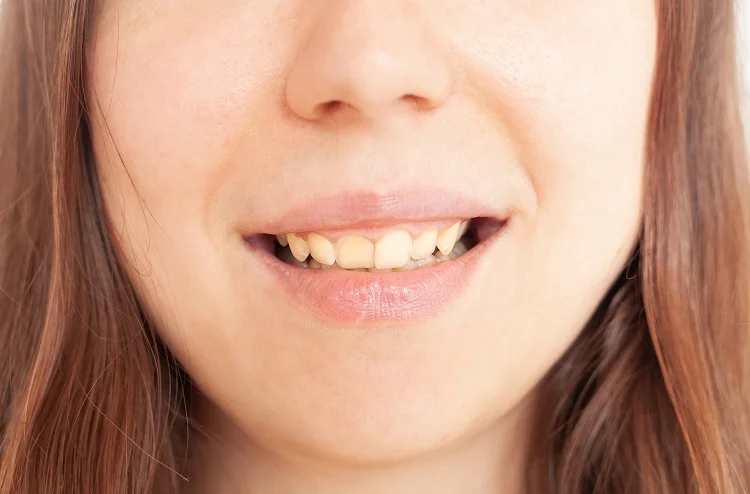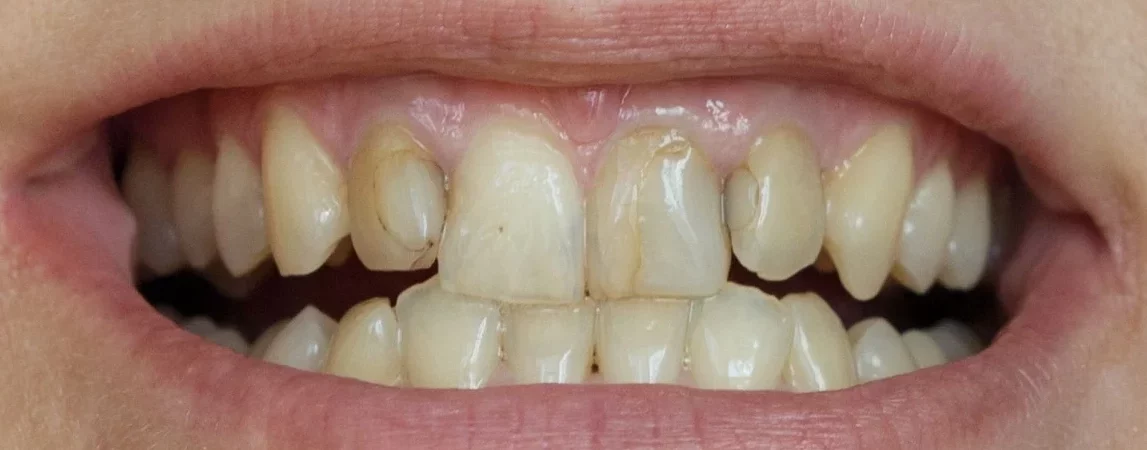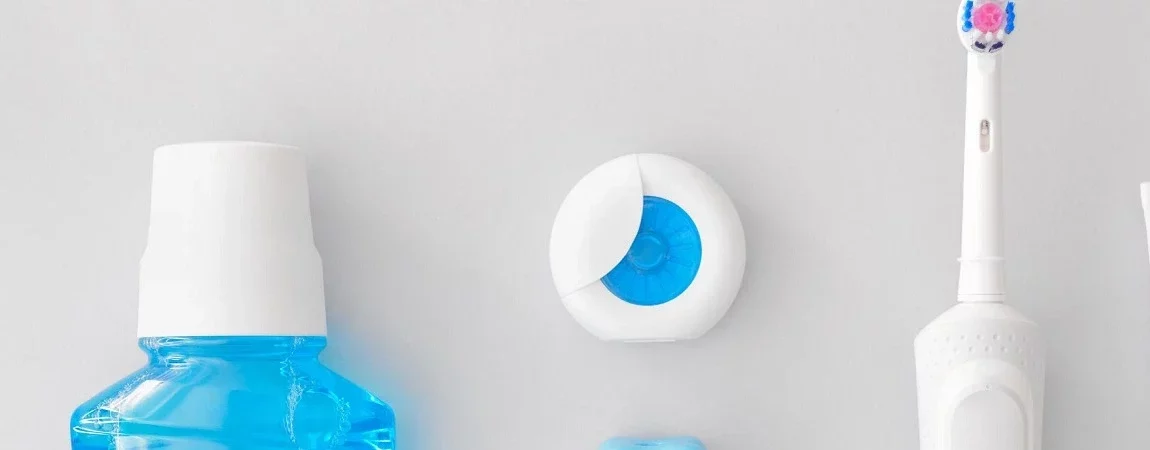Last Updated on: 27th December 2025, 08:02 am
The teeth of a person with anorexia may show enamel wear, transparent areas on the edges, yellowish color from exposed dentin, and increased sensitivity, mainly due to erosion caused by frequent vomiting and nutritional deficiencies.
In this article, we will discuss the effects of eating disorders on oral structures, anorexia teeth, and bulimia teeth. By the year 2020, it was estimated that nearly 30 million Americans suffered from some form of eating disorder. More and more people are being diagnosed with these diseases, which not only have negative effects on overall health but can severely impact oral health as well.
What are Eating Disorders?
According to the World Health Organization (WHO), they are a “group of disorders characterized by abnormal eating behaviors, accompanied by a distortion in the perception of body image, an excessive concern about weight and food.” These illnesses can compromise the patient’s overall health and even cause death.
Eating disorders are diseases with a significant psychological component, which can affect people of all ages, especially those between the ages of 12 and 25, with women being the most affected. It is well known that people with eating disorders are prone to developing other physical health problems, such as cardiovascular disease, diabetes, and other metabolic disorders, among many others. However, they also have a severe impact on the mental health and psychosocial development of those who suffer from them.
There are numerous types of eating disorders (EDs). Two of the most common are:
What Is Anorexia Nervosa and How Does It Affect Teeth?
Anorexia is characterized by severe self-restriction of food intake, resulting in a very low weight for height. This disorder is driven by an intense fear of gaining weight. It can occur in two ways:
- Restrictive: People achieve significant weight loss through strict diets, fasting, or physical exercise.
- Binge-eating/purging: Patients engage in behaviors where they consume large amounts of food in short periods to the point of feeling full, with or without subsequent use of laxatives.
Over time, due to an inevitable nutrient deficiency, people with anorexia develop various psychological and physical symptoms, including digestive problems, dizziness, fainting, brittle hair and nails, and gastroesophageal reflux, among others.
What Is Bulimia Nervosa and How Does It Affect Teeth?
Bulimia is a disorder characterized by alternating the consumption of healthy or safe foods with binge-eating episodes of high-calorie foods. These binges are often associated with feelings of guilt and shame, are very large, and involve consuming food beyond satiety. Generally, these episodes are followed by “compensatory behaviors” to avoid weight gain, which may include fasting, vomiting, laxative abuse, or compulsive exercise. People with bulimia may have low weight, normal weight, or even obesity.
With the persistence of this disorder, significant gastrointestinal lesions develop, as well as multiple oral problems related to the induced vomiting episodes.
How do Eating Disorders Affect Teeth?
Many eating disorders involve behaviors that include vomiting, which causes damage to oral cavity structures such as teeth or soft tissues. Likewise, binge eating usually involves consuming high-carbohydrate foods, which significantly increases the risk of tooth decay.
Several studies have shown that these can lead to some oral health problems, including:
- Soft tissue oral lesions
- Cavities
- Xerostomia (decreased salivation)
- Inflammation of the salivary glands
- Dental erosion
- Periodontal disease
What Is Decreased Salivary Flow and How Does It Impact Oral Health?
It is common for salivary gland function to begin to fail in the face of eating disorders, greatly reducing saliva flow. This can also be exacerbated by the use of antidepressant medications.
Saliva performs several important functions, such as protecting teeth and soft tissues, remineralizing teeth to prevent cavities, cleaning dental surfaces, defensive action against infections, and maintaining an appropriate pH (preventing acidity in the mouth). Therefore, in the face of low salivation, it is common for patients to develop some oral health pathologies, including:
- Cavities
- Dental erosion
- Soft tissue injuries
What Is Dental Erosion and What Causes It?
Dental erosion is a loss of dental tissue that is not mediated by bacteria but is associated with damage to the structure of the teeth by contact with chemicals.
What Causes Dental Erosion?
Dental erosions are frequently found in people who consume large amounts of citrus drinks or soda, but also in patients with gastric reflux or who vomit frequently, as occurs in some types of eating disorders. This is because the stomach produces large amounts of acid every day to be able to digest food, and when vomiting, this acid reaches the mouth.
The structures of the mouth are not prepared or adapted to such acidic substances, so they begin to deteriorate. In addition to this, to eliminate the acidic taste from the mouth, patients often brush their teeth more often than normal, which, combined with contact with acids, can further deteriorate tooth enamel. Dental erosion could also worsen if there is a decrease in salivary flow or hyposalivation.
What Are the Signs and Symptoms of Dental Erosion?
Patients with dental erosion may have:
1. Transparent areas on the edges of the teeth: Dental enamel begins to wear away and becomes increasingly translucent.
2. Teeth with a yellowish appearance: Wear on the outermost layer of the tooth (enamel) can expose the yellowish color of dentin, which is the layer just below.
3. Increased dental sensitivity: Discomfort in response to stimuli of cold or heat, due to wear on the hard layers of the tooth that protect the nerve.
What Are the Best Tips for Maintaining Oral Health in Patients with Eating Disorders?
The best option for avoiding dental wear and salivation problems is to decrease repeated vomiting episodes and normalize eating behavior. However, this is usually achieved through professional support and specialized treatment that often yields positive results progressively. In this way, while the patient manages to control these behaviors, they can follow some tips to reduce the progression of damage to the structures in the oral cavity:
1. Rinse with fluoride
Fluoride helps to restore lost minerals in the teeth, strengthening them and making them less susceptible to erosion.
2. Do not brush your teeth after vomiting
It is preferred to rinse only with water or fluoride solutions, as brushing teeth that have recently been exposed to contact with stomach acids could worsen enamel damage.
3. Oral hygiene
Brushing your teeth three times a day with fluoridated toothpaste (except during vomiting episodes) and using dental floss to prevent the appearance of cavities. Curious about the best toothpaste to promote gum health? Click here to know more.
4. Gentle but efficient toothbrushing
It is important to maintain proper oral hygiene, however, it is recommended to use soft-bristled toothbrushes to avoid further damaging the dental surface.
5. Visiting the dentist
People with eating disorders can have multiple oral health problems. The dentist can offer multiple solutions to stop the progression of the condition and regain lost dental structure.
6. Chewing sugar-free gum
Chewing gum helps stimulate salivation. As mentioned before, saliva has multiple benefits that contribute to the protection of oral tissues and teeth.
7. Remineralization and dental protection
The dentist may suggest treatments focused on stopping the progression of the disease, to avoid further loss of dental structure, including:
- Application of fluorides to strengthen enamel.
- Customized trays with alkaline substances after or during vomiting.
What Are the Treatments for Dental Erosion Caused by Eating Disorders?
Treatment for dental erosion usually represents a challenge for dentists, due to the chemical changes in the dental structure that make the materials normally used to restore teeth adhere less easily. Therefore, prevention of these wear and tear is highly recommended.
In some cases, to prevent further dental wear, promoting the remineralization of dental tissue is recommended, and depending on the degree of wear, the dentist may choose not to perform restoration treatments to avoid further wear of the teeth. However, when there are significant aesthetic implications, there are treatments available to restore the shape of the teeth.
These may include:
- Resin restorations
- Porcelain veneers
- Crowns
Conclusion
Eating disorders require specialized attention from an interdisciplinary group of expert professionals. Patients with these conditions usually undergo therapies to overcome the implications of their condition, but eliminating harmful eating behaviors takes time. It is important to adopt prevention and treatment measures for oral disorders that prevent further damage like anorexia teeth.
Share:
Voice and Search (Q&A)
What do anorexia teeth look like?
They have worn enamel, transparent edges, a yellowish color, and may be more sensitive to hot or cold.
Why does anorexia damage teeth?
Because frequent vomiting exposes teeth to stomach acids, and nutrient deficiencies weaken the enamel.
Can teeth damaged by anorexia be restored?
In some cases, yes, with treatments such as fluoride, remineralization, and dental restorations — but prevention is key.
References
1. Arija Val, V., Santi Cano, M. J., Novalbos Ruiz, J. P., Canals, J., & Rodríguez Martín, A. (2022). Characterization, epidemiology and trends of eating disorders. Nutricion hospitalaria: organo oficial de la Sociedad Espanola de Nutricion Parenteral y Enteral, 39(Spec2), 8–15. https://doi.org/10.20960/nh.04173
2. Bretz, W. A. (2002). Oral profiles of bulimic women: Diagnosis and management. What is the evidence? The Journal of Evidence-Based Dental Practice, 2(4), 267–272. https://doi.org/10.1016/s1532-3382(02)70078-x
3. Johansson, A.-K., Omar, R., Carlsson, G. E., & Johansson, A. (2012). Dental erosion and its growing importance in clinical practice: from past to present. International Journal of Dentistry, 2012, 632907. https://doi.org/10.1155/2012/632907
4. Silverstein, L. S., Haggerty, C., Sams, L., Phillips, C., & Roberts, M. W. (2019). Impact of an oral health education intervention among a group of patients with eating disorders (anorexia nervosa and bulimia nervosa). Journal of Eating Disorders, 7(1), 29. https://doi.org/10.1186/s40337-019-0259-x
5. Valdez, R. (2021, octubre 18). How does bulimia affect the teeth? Verywell Health. https://www.verywellhealth.com/bulimia-teeth-5203972
6. Psychiatry.org. Recuperado el 28 de marzo de 2023, de https://www.psychiatry.org/patients-families/eating-disorders
7. Whatson, S. (Dec 16, 2016). Bulimia’s Effect on Teeth. https://www.healthline.com/health/bulimia-teeth
-
Nayibe Cubillos M. [Author]
Pharmaceutical Chemestry |Pharmaceutical Process Management | Pharmaceutical Care | Pharmaceutical Services Audit | Pharmaceutical Services Process Consulting | Content Project Manager | SEO Knowledge | Content Writer | Leadership | Scrum Master
View all posts
A healthcare writer with a solid background in pharmaceutical chemistry and a thorough understanding of Colombian regulatory processes and comprehensive sector management, she has significant experience coordinating and leading multidisciplina...



















